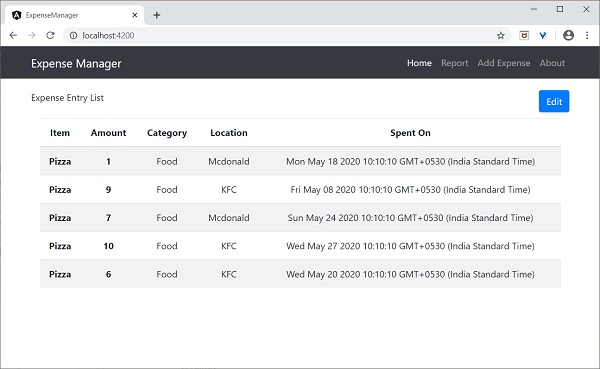
- Angular 8 教程
- Angular 8 - 主页
- Angular 8 - 简介
- Angular 8 - 安装
- 创建第一个应用程序
- Angular 8 - 架构
- Angular 组件和模板
- Angular 8 - 数据绑定
- Angular 8 - 指令
- Angular 8 - 管道
- Angular 8 - 响应式编程
- 服务和依赖注入
- Angular 8 - Http 客户端编程
- Angular 8 - 角度材料
- 路线和导航
- Angular 8 - 动画
- Angular 8 - 表单
- Angular 8 - 表单验证
- 认证与授权
- Angular 8 - 网络工作者
- Service Worker 和 PWA
- Angular 8 - 服务器端渲染
- Angular 8 - 国际化 (i18n)
- Angular 8 - 辅助功能
- Angular 8 - CLI 命令
- Angular 8 - 测试
- Angular 8 - Ivy 编译器
- Angular 8 - 使用 Bazel 构建
- Angular 8 - 向后兼容性
- Angular 8 - 工作示例
- Angular 9 - 有什么新变化?
- Angular 8 有用资源
- Angular 8 - 快速指南
- Angular 8 - 有用的资源
- Angular 8 - 讨论
Angular 8 - 指令
Angular 8 指令是与应用程序交互的 DOM 元素。一般来说,指令是一个TypeScript函数。当这个函数执行时,Angular编译器会在 DOM 元素中检查它。Angular 指令以ng-开头,其中ng代表 Angular,并使用@directive装饰器扩展 HTML 标签。
指令使逻辑能够包含在 Angular 模板中。Angular 指令可以分为三类,如下所示:
属性指令
用于为现有 HTML 元素添加新属性以更改其外观和Behave。
<HTMLTag [attrDirective]='value' />
例如,
<p [showToolTip]='Tips' />
这里,showToolTip引用了一个示例指令,当在 HTML 元素中使用该指令时,当用户将鼠标悬停在 HTML 元素上时将显示提示。
结构指令
用于在当前 HTML 文档中添加或删除 DOM 元素。
<HTMLTag [structuralDirective]='value' />
例如,
<div *ngIf="isNeeded"> Only render if the *isNeeded* value has true value. </div>
这里,ngIf是一个内置指令,用于在当前HTML文档中添加或删除HTML元素。Angular 提供了许多内置指令,我们将在后面的章节中学习。
基于组件的指令
组件可以用作指令。每个组件都有输入和输出选项,用于在组件与其父级 HTML 元素之间传递。
<component-selector-name [input-reference]="input-value"> ... </component-selector-name>
例如,
<list-item [items]="fruits"> ... </list-item>
这里,list-item是一个组件,items是输入选项。我们将在后面的章节中学习如何创建组件和高级用法。
在进入本主题之前,让我们在 Angular 8 中创建一个示例应用程序(directive-app)来学习知识。
打开命令提示符并使用以下命令创建新的 Angular 应用程序 -
cd /go/to/workspace ng new directive-app cd directive-app
使用 Angular CLI创建一个测试组件,如下所述 -
ng generate component test
上面创建了一个新组件,输出如下 -
CREATE src/app/test/test.component.scss (0 bytes) CREATE src/app/test/test.component.html (19 bytes) CREATE src/app/test/test.component.spec.ts (614 bytes) CREATE src/app/test/test.component.ts (262 bytes) UPDATE src/app/app.module.ts (545 bytes)
使用以下命令运行应用程序 -
ng serve
DOM 概述
让我们简单看一下 DOM 模型。DOM 用于定义访问文档的标准。一般来说,HTML DOM 模型被构造为对象树。它是访问 html 元素的标准对象模型。
我们可以在 Angular 8 中使用 DOM 模型,原因如下:
- 我们可以使用 DOM 元素轻松导航文档结构。
- 我们可以轻松添加 html 元素。
- 我们可以轻松更新元素及其内容。
结构指令
结构指令通过添加或删除元素来更改DOM的结构。它由 * 符号表示,具有三个预定义指令NgIf、NgFor和NgSwitch。我们来简单的一一了解一下。
NgIf指令
NgIf指令用于根据条件为真或假来显示或隐藏应用程序中的数据。我们可以将其添加到模板中的任何标签中。
让我们在指令应用程序中尝试ngIf指令。
在test.component.html中添加以下标签。
<p>test works!</p> <div *ngIf="true">Display data</div>
在app.component.html文件中添加测试组件,如下所示 -
<app-test></app-test>
使用以下命令启动服务器(如果尚未启动) -
ng serve
现在,运行您的应用程序,您可以看到以下响应 -
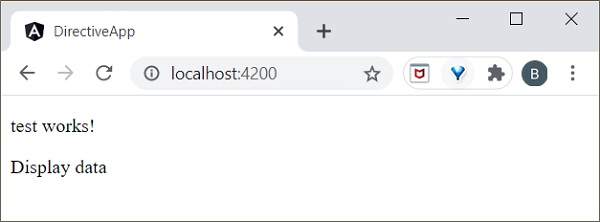
如果设置条件ngIf=“false”那么内容将被隐藏。
ngIfElse 指令
ngIfElse与ngIf类似,但它也提供了在失败情况下渲染内容的选项。
让我们通过一个示例来了解ngIfElse 的工作原理。
在test.component.ts文件中添加以下代码。
export class TestComponent implements OnInit {
isLogIn : boolean = false;
isLogOut : boolean = true;
}
在test.component.html文件中添加以下代码,如下所示 -
<p>ngIfElse example!</p> <div *ngIf="isLogIn; else isLogOut"> Hello you are logged in </div> <ng-template #isLogOut> You're logged out.. </ng-template>
最后,使用以下命令启动您的应用程序(如果尚未完成) -
ng serve
现在,运行您的应用程序,您可以看到以下响应 -
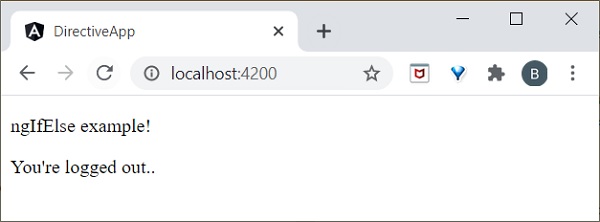
这里,
是注销
value 被指定为true,因此它会转到else块并呈现ng-template。我们将在本章后面学习ng-template 。ngFor 指令
ngFor 用于重复项目列表中的一部分元素。
让我们通过一个示例来了解 ngFor 的工作原理。
在 test.component.ts 文件中添加列表,如下所示 -
list = [1,2,3,4,5];
在test.component.html中添加ngFor指令,如下所示 -
<h2>ngFor directive</h2>
<ul>
<li *ngFor="let l of list">
{{l}}
</li>
</ul>
在这里,let 关键字创建一个局部变量,可以在模板中的任何位置引用它。let l 创建一个模板局部变量来获取列表元素。
最后,使用以下命令启动您的应用程序(如果尚未完成) -
ng serve
现在,运行您的应用程序,您可以看到以下响应 -
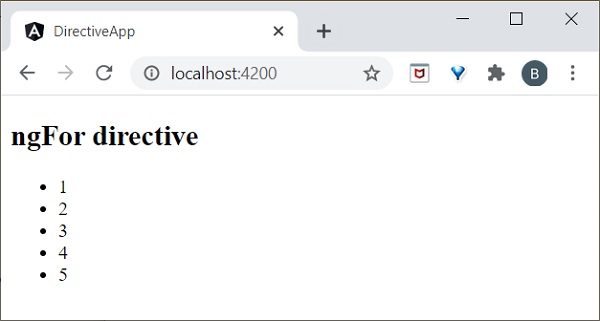
音轨
有时,对于大型列表, ngFor性能较低。例如,当添加新项目或删除列表中的任何项目时可能会触发多个 DOM 操作。为了迭代大型对象集合,我们使用trackBy。
它用于跟踪何时添加或删除元素。它是通过 trackBy 方法执行的。它有两个参数索引和元素。索引用于唯一地标识每个元素。简单的例子定义如下。
让我们通过一个示例来了解 trackBy 如何与ngFor一起工作。
在test.component.ts文件中添加以下代码。
export class TestComponent {
studentArr: any[] = [ {
"id": 1,
"name": "student1"
},
{
"id": 2,
"name": "student2"
},
{
"id": 3, "name": "student3"
},
{
"id": 4,
"name": "student4"
}
];
trackByData(index:number, studentArr:any): number {
return studentArr.id;
}
这里,
我们创造了,
trackByData()
方法根据 id 以独特的方式访问每个学生元素。在test.component.html文件中添加以下代码以在 ngFor 中定义 trackBy 方法。
<ul>
<li *ngFor="let std of studentArr; trackBy: trackByData">
{{std.name}}
</li>
</ul>
最后,使用以下命令启动您的应用程序(如果尚未完成) -
ng serve
现在,运行您的应用程序,您可以看到以下响应 -
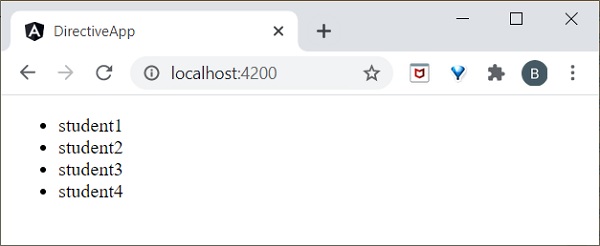
在这里,应用程序将打印学生姓名。现在,应用程序使用学生 ID 而不是对象引用来跟踪学生对象。因此,DOM 元素不受影响。
NgSwitch 指令
NgSWitch用于检查多个条件并保持 DOM 结构简单易懂。
让我们在指令应用程序中尝试ngSwitch指令。
在test.component.ts文件中添加以下代码。
export class TestComponent implements OnInit {
logInName = 'admin';
}
在 test.component.html 文件中添加以下代码,如下所示 -
<h2>ngSwitch directive</h2>
<ul [ngSwitch]="logInName">
<li *ngSwitchCase="'user'">
<p>User is logged in..</p>
</li>
<li *ngSwitchCase="'admin'">
<p>admin is logged in</p>
</li>
<li *ngSwitchDefault>
<p>Please choose login name</p>
</li>
</ul>
最后,使用以下命令启动您的应用程序(如果尚未完成) -
ng serve
现在,运行您的应用程序,您可以看到以下响应 -
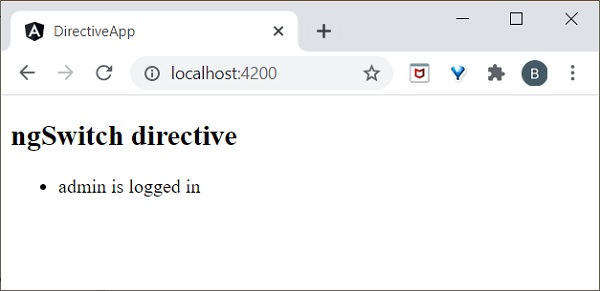
在这里,我们将logInName定义为admin。因此,它匹配第二个 SwitchCase 并打印上面的管理相关消息。
属性指令
属性指令执行 DOM 元素或组件的外观或Behave。其中一些示例包括 NgStyle、NgClass 和 NgModel。而 NgModel 是前一章中解释的双向属性数据绑定。
ng风格
ngStyle指令用于添加动态样式。下面的示例用于将蓝色应用于段落。
让我们在指令应用程序中尝试ngStyle指令。
在test.component.html文件中添加以下内容。
<p [ngStyle]="{'color': 'blue', 'font-size': '14px'}">
paragraph style is applied using ngStyle
</p>
使用以下命令启动您的应用程序(如果尚未完成) -
ng serve
现在,运行您的应用程序,您可以看到以下响应 -
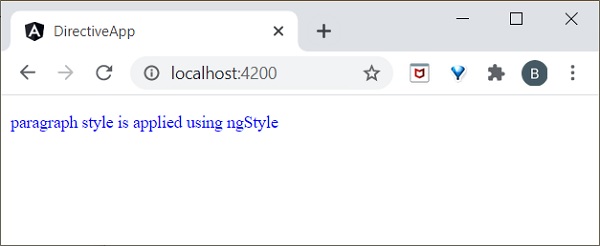
ng类
ngClass用于在 HTML 元素中添加或删除 CSS 类。
让我们在指令应用程序中尝试ngClass指令。
使用以下命令创建一个用户类
ng g class User
您可以看到以下响应 -
CREATE src/app/user.spec.ts (146 bytes) CREATE src/app/user.ts (22 bytes)
移至src/app/user.ts文件并添加以下代码 -
export class User {
userId : number; userName : string;
}
在这里,我们在User类中创建了两个属性userId和userName。
打开test.component.ts文件并添加以下更改 -
import { User } from '../user';
export class TestComponent implements OnInit {
users: User[] = [
{
"userId": 1,
"userName": 'User1'
},
{
"userId": 2,
"userName": 'User2'
},
];
}
在这里,我们声明了一个局部变量 users 并用 2 个用户对象进行初始化。
打开test.component.css文件并添加以下代码
.highlight {
color: red;
}
打开test.component.html文件并添加以下代码 -
<div class="container">
<br/>
<div *ngFor="let user of users" [ngClass]="{
'highlight':user.userName === 'User1'
}">
{{ user.userName }}
</div>
</div>
这里,
我们已经为User1应用了ngClass,因此它将突出显示User1。
最后,使用以下命令启动您的应用程序(如果尚未完成) -
ng serve
现在,运行您的应用程序,您可以看到以下响应 -
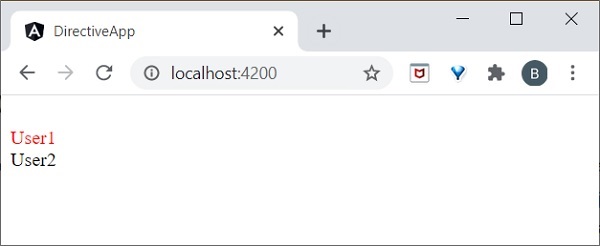
自定义指令
Angular 提供了使用用户定义的指令来扩展 Angular 指令的选项,它被称为自定义指令。让我们在本章中学习如何创建自定义指令。
让我们尝试在指令应用程序中创建自定义指令。
Angular CLI 提供了以下命令来创建自定义指令。
ng generate directive customstyle
执行此命令后,您可以看到以下响应 -
CREATE src/app/customstyle.directive.spec.ts (244 bytes) CREATE src/app/customstyle.directive.ts (151 bytes) UPDATE src/app/app.module.ts (1115 bytes)
打开app.module.ts。该指令将通过声明元数据在AppModule中配置。
import { CustomstyleDirective } from './customstyle.directive';
@NgModule({
declarations: [
AppComponent,
TestComponent,
CustomstyleDirective
]
})
打开customstyle.directive.ts文件并添加以下代码 -
import { Directive, ElementRef } from '@angular/core';
@Directive({
selector: '[appCustomstyle]'
})
export class CustomstyleDirective {
constructor(el: ElementRef) {
el.nativeElement.style.fontSize = '24px';
}
}
在这里,构造函数方法使用CustomStyleDirective作为el获取元素。然后,它访问 el 的样式并使用 CSS 属性将其字体大小设置为24px。
最后,使用以下命令启动您的应用程序(如果尚未完成) -
ng serve
现在,运行您的应用程序,您可以看到以下响应 -
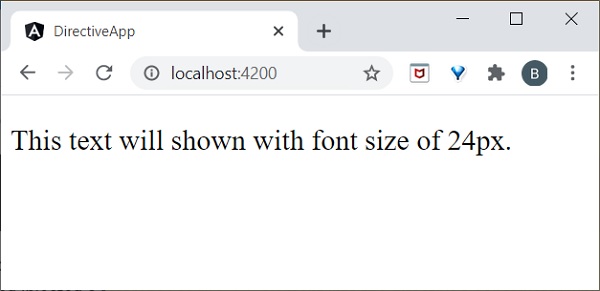
ng-模板
ng-template用于创建动态且可重用的模板。它是一个虚拟元素。如果您使用ng-template编译代码,则会将其转换为 DOM 中的注释。
例如,
让我们在test.component.html页面中添加以下代码。
<h3>ng-template</h3> <ng-template>ng-template tag is a virtual element</ng-template>
如果运行该应用程序,它将仅打印h3元素。检查您的页面源代码,模板显示在评论部分,因为它是虚拟元素,因此它不会呈现任何内容。我们需要将ng-template与 Angular 指令一起使用。
通常,指令会发出与其关联的 HTML 标记。有时,我们不需要标签,而只需要内容。例如,在下面的示例中,将发出 li。
<li *ngFor="let item in list">{{ item }}</li>
我们可以使用ng-template来安全地跳过li标签。
带有结构指令的 ng-template
ng-template应始终在ngIf、ngFor或ngSwitch指令内使用来呈现结果。
让我们假设简单的代码。
<ng-template [ngIf]=true> <div><h2>ng-template works!</h2></div> </ng-template>
在这里,如果ngIf条件成立,它将打印 div 元素内的数据。同样,您也可以使用ngFor和ngSwitch指令。
NgForOf指令
ngForOf也是一个结构指令,用于呈现集合中的项目。下面的示例用于显示ng-template中的ngForOf指令。
import { Component, OnInit } from '@angular/core';
@Component({
selector: 'app-test',
template: `
<div>
<ng-template ngFor let-item [ngForOf]="Fruits" let-i="index">
<p>{{i}}</p>
</ng-template>
</div>`
,
styleUrls: ['./test.component.css']
})
export class TestComponent implements OnInit {
Fruits = ["mango","apple","orange","grapes"];
ngOnInit()
{
}
}
如果运行该应用程序,它将显示每个元素的索引,如下所示 -
0 1 2 3
组件指令
组件指令基于组件。实际上,每个组件都可以用作指令。组件提供@Input和@Output装饰器来在父组件和子组件之间发送和接收信息。
让我们尝试在指令应用程序中使用组件作为指令。
使用以下命令创建一个新的ChildComponent -
ng generate component child CREATE src/app/child/child.component.html (20 bytes) CREATE src/app/child/child.component.spec.ts (621 bytes) CREATE src/app/child/child.component.ts (265 bytes) CREATE src/app/child/child.component.css (0 bytes) UPDATE src/app/app.module.ts (466 bytes)
打开child.component.ts并添加以下代码 -
@Input() userName: string;
在这里,我们为ChildComponent设置一个输入属性。
打开child.component.html并添加以下代码 -
<p>child works!</p>
<p>Hi {{ userName }}</p>
在这里,我们使用值 userName 来欢迎用户。
打开test.component.ts并添加以下代码 -
name: string = 'Peter';
打开test.component.html并添加以下代码 -
<h1>Test component</h1> <app-child [userName]="name"><app-child>
在这里,我们在TestComponent中使用AppComponent作为具有输入属性的指令。
最后,使用以下命令启动您的应用程序(如果尚未完成) -
ng serve
现在,运行您的应用程序,您可以看到以下响应 -
[](images/directive-app/component_as_directive.PNG"
工作示例
让我们在ExpenseManager应用程序中添加一个新组件来列出费用条目。
打开命令提示符并转到项目根文件夹。
cd /go/to/expense-manager
启动应用程序。
ng serve
使用以下命令创建一个新组件ExpenseEntryListComponent -
ng generate component ExpenseEntryList
输出
输出如下 -
CREATE src/app/expense-entry-list/expense-entry-list.component.html (33 bytes) CREATE src/app/expense-entry-list/expense-entry-list.component.spec.ts (700 bytes) CREATE src/app/expense-entry-list/expense-entry-list.component.ts (315 bytes) CREATE src/app/expense-entry-list/expense-entry-list.component.css (0 bytes) UPDATE src/app/app.module.ts (548 bytes)
此处,该命令创建 ExpenseEntryList 组件并更新AppModule中的必要代码。
将ExpenseEntry导入ExpenseEntryListComponent组件(src/app/expense-entry-list/expense-entry-list.component)
import { ExpenseEntry } from '../expense-entry';
添加方法getExpenseEntries()以返回ExpenseEntryListComponent (src/app/expense-entry-list/expense-entry-list.component)中的费用条目列表(模拟项目)
getExpenseEntries() : ExpenseEntry[] {
let mockExpenseEntries : ExpenseEntry[] = [
{ id: 1,
item: "Pizza",
amount: Math.floor((Math.random() * 10) + 1),
category: "Food",
location: "Mcdonald",
spendOn: new Date(2020, 4, Math.floor((Math.random() * 30) + 1), 10, 10, 10),
createdOn: new Date(2020, 4, Math.floor((Math.random() * 30) + 1), 10, 10, 10) },
{ id: 1,
item: "Pizza",
amount: Math.floor((Math.random() * 10) + 1),
category: "Food",
location: "KFC",
spendOn: new Date(2020, 4, Math.floor((Math.random() * 30) + 1), 10, 10, 10),
createdOn: new Date(2020, 4, Math.floor((Math.random() * 30) + 1), 10, 10, 10) },
{ id: 1,
item: "Pizza",
amount: Math.floor((Math.random() * 10) + 1),
category: "Food",
location: "Mcdonald",
spendOn: new Date(2020, 4, Math.floor((Math.random() * 30) + 1), 10, 10, 10),
createdOn: new Date(2020, 4, Math.floor((Math.random() * 30) + 1), 10, 10, 10) },
{ id: 1,
item: "Pizza",
amount: Math.floor((Math.random() * 10) + 1),
category: "Food",
location: "KFC",
spendOn: new Date(2020, 4, Math.floor((Math.random() * 30) + 1), 10, 10, 10),
createdOn: new Date(2020, 4, Math.floor((Math.random() * 30) + 1), 10, 10, 10) },
{ id: 1,
item: "Pizza",
amount: Math.floor((Math.random() * 10) + 1),
category: "Food",
location: "KFC",
spendOn: new Date(2020, 4, Math.floor((Math.random() * 30) + 1), 10, 10, 10),
createdOn: new Date(2020, 4, Math.floor((Math.random() * 30) + 1), 10, 10, 10)
},
];
return mockExpenseEntries;
}
声明一个局部变量,expenseEntries 并加载费用条目的模拟列表,如下所述 -
title: string;
expenseEntries: ExpenseEntry[];
constructor() { }
ngOnInit() {
this.title = "Expense Entry List";
this.expenseEntries = this.getExpenseEntries();
}
打开模板文件(src/app/expense-entry-list/expense-entry-list.component.html)并在表中显示模拟条目。
<!-- Page Content -->
<div class="container">
<div class="row">
<div class="col-lg-12 text-center" style="padding-top: 20px;">
<div class="container" style="padding-left: 0px; padding-right: 0px;">
<div class="row">
<div class="col-sm" style="text-align: left;">
{{ title }}
</div>
<div class="col-sm" style="text-align: right;">
<button type="button" class="btn btn-primary">Edit</button>
</div>
</div>
</div>
<div class="container box" style="margin-top: 10px;">
<table class="table table-striped">
<thead>
<tr>
<th>Item</th>
<th>Amount</th>
<th>Category</th>
<th>Location</th>
<th>Spent On</th>
</tr>
</thead>
<tbody>
<tr *ngFor="let entry of expenseEntries">
<th scope="row">{{ entry.item }}</th>
<th>{{ entry.amount }}</th>
<td>{{ entry.category }}</td>
<td>{{ entry.location }}</td>
<td>{{ entry.spendOn | date: 'short' }}</td>
</tr>
</tbody>
</table>
</div>
</div>
</div>
</div>
这里,
使用引导表。table和table-striped将根据 Boostrap 样式标准对桌子进行样式设置。
使用ngFor循环费用条目并生成表行。
打开AppComponent模板src/app/app.component.html并包含ExpenseEntryListComponent并删除ExpenseEntryComponent,如下所示 -
... <app-expense-entry-list></app-expense-entry-list>
最后,应用程序的输出如下所示。
